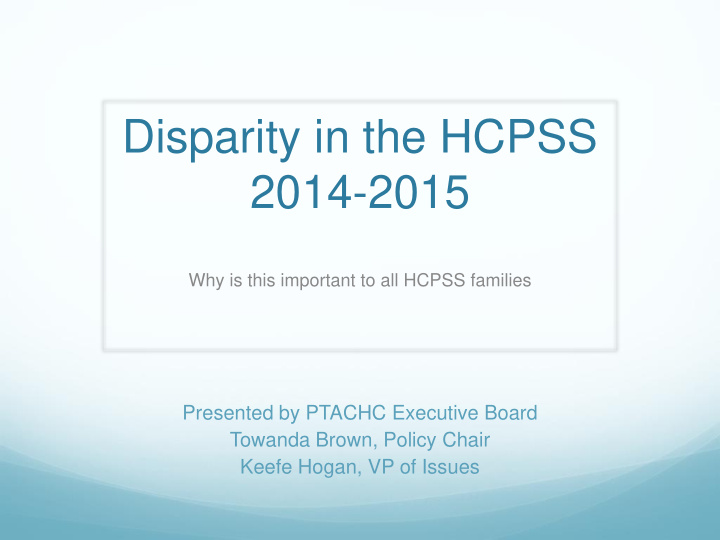



Disparity in the HCPSS 2014-2015 Why is this important to all HCPSS families Presented by PTACHC Executive Board Towanda Brown, Policy Chair Keefe Hogan, VP of Issues
What is Disparity A lack of similarity or equality, often due to race or social-economic status A comparison of the percentage of the population versus the percentage of the measurement All HCPSS grades were desegregated by 1964, but segregated schools remained and many black students were educated in facilities with no white students Source: http://www.hcpss.org/news- posts/2015/11/howard-county-celebrates-50-years-of- school-desegregation/
Caveat on the data results All statistics did not reconcile based on school privacy. If the students who were suspended are less than a minimum percentage for reporting, the numbers were not included The statistics do not account for repeat suspensions for a particular student, just recorded suspensions
Elementary School Suspensions Population / Male Female Total Suspensions Suspensions Suspensions (Pop / Susp) (Pop / Susp) 1% of the 51% of the 49% of the population population population (199) (167) (32) Asian 15% / 5% 15% / 5% 15% / 3% Black 32% / 57% 32% / 55% 32% / 69% Hispanic 9% / 9% 9% / 9% 9% / 6% White 41% / 22% 40% / 23% 41% / 16% Two or More 3% / 7% 4% / 7% 3% / 6%
Middle School Suspensions* Population / Male Female Total Suspensions Suspensions Suspensions (Pop / Susp) (Pop / Susp) 5% of the 52% of the 48% of the population population population (561) (413) (144) Asian 13% / 3% 13% / 4% 15% / 1% Black 24% / 64% 25% / 55% 22% / 75% Hispanic 10% / 14% 10% / 13% 9% / 11% White 47% / 12% 47% / 14% 48% / 7% Two or More 6% / 7% 5% / 7% 6% / 6% * Biggest data discrepancy on suspension data
High School Suspensions Population / Male Female Total Suspensions Suspensions Suspensions (Pop / Susp) (Pop / Susp) 3% of the 51% of the 49% of the population (517) population population (354) (162) Asian 16% / 5% 16% / 7% 16% / 1% Black 22% / 52% 22% / 52% 23% / 54% Hispanic 9% / 13% 9% / 11% 9% / 16% White 48% / 25% 48% / 25% 48% / 24% Two or More 5% / 4% 5% / 4% 4% / 4%
Advanced Placement Identification of students for Advanced Courses starts in elementary school A study shows racial basis among preschool teachers Yale study suggests racial bias among preschool teachers Yes, Preschool Teachers Really Do Treat Black And White Children Totally Differently
Advanced Placement starts in Elementary school Curriculum Extension Units (CEUs) can be offered in 1 st grade. Advanced Math begins in 4 th grade with students identified as early as the 3 rd grade o Elementary students not invited to participate call these students “the smart kids”. What mindset does this set for them regarding what they are capable of accomplishing?
Advanced Placement • For the first time in 2015, for 1 st grade, minorities have more participation in CEUs than their population Population Enrollment in CEUs 15% of the population is in CEUs Asian 21% 18% Black 22% 30% Hispanic 7% 10% White 42% 35% Two or More 8% 7%
Impact to Students Self-esteem o Children start to believe that they are bad who can’t do anything right Self-confidence o Children start to believe that they are incapable of achieving
Impact to the Community Schools with high suspension rates have more negative and hostile student-student relationships than schools with low suspension rates o Includes more class disruption which impacts all students in the classroom These students are in the same communities as your students, they will most likely encounter one another Other students are seeing mistreatment as acceptable in our culture/society
What can we do as PTA/PTSA organizations Talk with the principal and ask how the PTA can support the school o Asking for suspension data may cause suspicion/distrust Help identify sources for the families where the students are struggling, perhaps form a bond/sense of community by having working groups with the students, that includes school staff Provide a safe place for parents and students (particularly at the middle and high school levels) to express their concerns regarding inequities they have experienced or noticed (their voices matter)
Recommend
More recommend